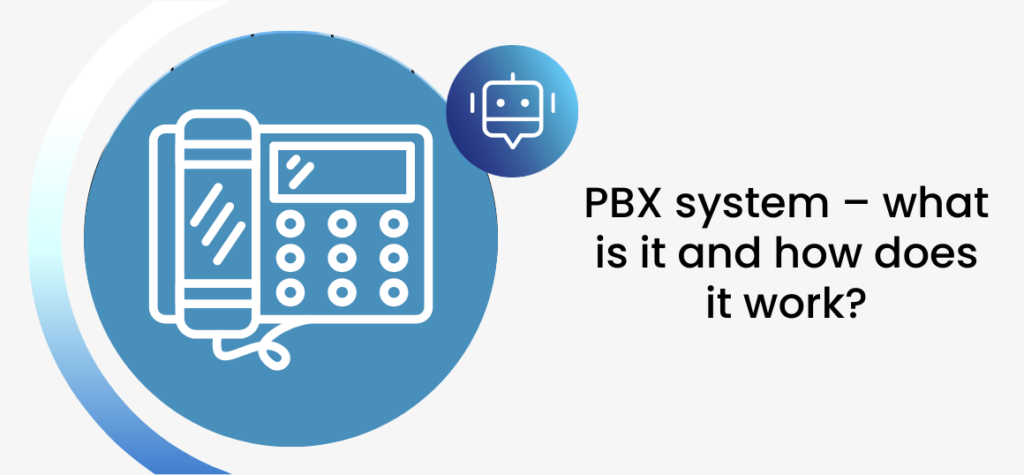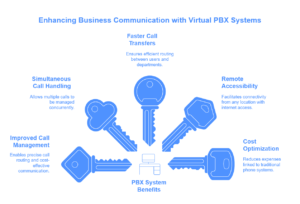PBX system – what is it and how does it work?

PBX – what is it and how does it work?
Are you looking for a solution to optimize your business costs while improving communication efficiency? For years, PBX telephone systems have been used for this purpose. However, traditional analog solutions are increasingly being replaced by cloud-based systems due to their enhanced functionality and better alignment with modern business needs. But what exactly is a PBX system, how has it evolved over time, and how does it work? Let’s take a closer look.
PBX system – what is it?
PBX – what is it? In short, PBX (Private Branch Exchange) is a telecommunication system in the form of a telephone exchange. It is designed to manage internal communications within a company or organization. A PBX system is a private switchboard that enables the simultaneous receiving and making of phone calls from multiple numbers within a single network. This network is specifically designed and implemented to meet the needs of a given company. In the case of a traditional PBX system, its foundation is a physical server room or server rack. This requires allocating additional space within the organization to house specialized equipment. Such a system, based on telecommunication cables connected to a local service provider, is known as POTS (Plain Old Telephone System).
Over the past few decades, PBX systems have evolved significantly. Early designs required an operator to be involved in the entire process. This meant that when a caller contacted a company, they were manually redirected by an operator to the appropriate department or specialist. The next step in development was replacing manual switchboards with electromagnetic and electronic systems. Today, the standard in advanced businesses is the use of PBX systems that support the IP protocol, known as VoIP for businesses, which operate based on cloud solutions. This represents the evolution of the traditional PBX system.

VoIP – a modern cloud-based phone system as the evolution of PBX
More and more businesses are opting for a modern phone system based on cloud solutions—this is VoIP telephony. It operates using the IP protocol, which relies on broadband internet. At the same time, data is stored in the cloud, reducing costs associated with purchasing hardware and maintaining an in-house server room. This functionality is provided by an IP PBX service provider. Additionally, this type of PBX system offers high flexibility and the ability to adjust its parameters according to the company’s current needs.
A virtual PBX system is designed to use SIP Trunk connections for IP-based communication. This allows employees to handle multiple calls simultaneously and manage the entire customer service process more efficiently. As a result, IP PBX systems are widely used in call centers, including inbound customer service hotlines. Voice calls are routed over the internet using the company’s existing network (e.g., for internal file transfers). This solution is both secure and cost-effective, optimizing infrastructure maintenance expenses. This is how PBX hosting works—by relying on an external service provider (e.g., our company, EasyCall). It’s no surprise that this model is growing in popularity compared to the traditional “on-premise” approach, where businesses maintain their entire infrastructure internally.
How does an IP PBX system work?
How does a cloud-based PBX system function? The core of employee-client communication is, of course, a telephone device. Within a virtual PBX system, users can utilize VoIP phones or dedicated applications for computers and smartphones. These devices connect to the PBX system via the SIP (Session Initiation Protocol). Once connected, each device receives its own internal extension number, which can be used for call forwarding and other functions.
The primary function of a PBX system is to receive incoming calls from customers and direct them to the appropriate department or a specific specialist by name. This process relies on pre-assigned internal extension numbers. Once configured, a virtual VoIP PBX system can also handle outbound calls, depending on the specific needs of the business.
Voice and video calls are conducted using the IP protocol. This means that sound is converted in real-time and transmitted over the internet. On the recipient’s end, the data is decoded and converted back into audio. This is the fundamental process behind how phone calls work within this system.
Benefits of a PBX system in business
Why should businesses consider implementing an IP PBX system? It is an excellent choice for organizations looking to optimize costs and reclaim valuable office space while modernizing their communication systems. The key benefits of deploying a virtual PBX system include:
- improved call management – businesses can set up precise call-routing paths and block international numbers to reduce costs;
- simultaneous call handling – the system allows for multiple incoming and outgoing calls at the same time;
- faster and more accurate call transfers – calls can be efficiently routed between users and departments, including call queuing;
- pre-recorded messages – companies can set up automated messages to guide customers;
- remote accessibility – employees can connect to the PBX system from anywhere with a stable internet connection;
- cost optimization – reduces the expenses associated with maintaining an on-premise phone system;
- increased convenience for employees – enhances the daily workflow of consultants and other specialists;
- better customer experience – improved communication efficiency positively impacts the company’s reputation.
The flexibility and versatility of a virtual VoIP PBX system make it the top choice for businesses seeking a reliable telephone network and improved operational efficiency. It is particularly beneficial for organizations with a distributed workforce or remote work model. Employees can easily connect to the cloud-based network and perform their tasks using smartphone applications and other digital solutions.

What to consider when choosing a PBX system for your business?
How to choose a service provider for your company? First and foremost, it’s essential to ensure that the parameters and functionalities of the virtual PBX system are tailored to your business needs. Some of the useful features include: call queuing, call recording, call forwarding, receiving faxes, IVR voice announcements. Additionally, make sure to take the following aspects into account:
- reviews of the provider and the reliability of their services;
- collaboration costs;
- security of the PBX system and the guarantees provided;
- scope of technical support covered by the contract;
- additional features offered within the service.
Customize the PBX system to fit your company and ensure secure, efficient operations along with improved management of incoming and outgoing calls. This will also help reduce infrastructure maintenance and PBX service costs. Get in touch with us, and we’ll show you how to leverage these benefits for your business!
